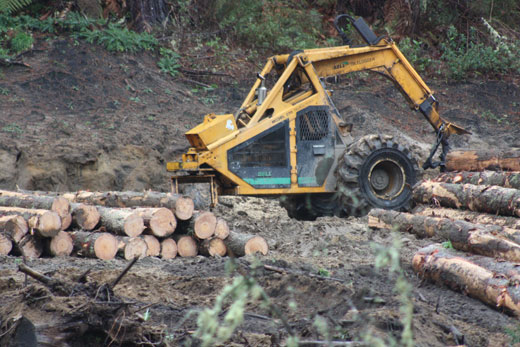Sweeping safety changes from the top down are being recommended for New Zealand's forestry sector in order to turn around what is the country's most dangerous industry.
The Independent Forestry Safety Review panel's final report released on Friday in Rotorua recommends a package of 11 practical measures with timeframes for implementation stretching from three months to three years.
It's expected to result in a significant reduction in the rate of serious injuries and fatalities in the forestry sector by 2017.
Independent Forestry Safety Review Panel chair George Adams, in the 141 page report, says the purpose of the panel's review was to identify the likely causes and contributing factors to the high rate of serious injuries and fatalities in the New Zealand forestry sector.
The forestry sector is regarded as the most dangerous sector in which to work, with a fatality rate that is 15 times the overall rate for all work sectors in NZ. Since 2008 there have been 32 death on forestry blocks nationwide.
A key finding in the report is the widespread industry view that a lax safety culture was acceptable due to the calibre of the workforce.
"Too often the Independent Forestry Safety Review Panel has been told about the challenges of dealing with a 'bottom of the barrel' workforce," says the report.
"A significant portion of the industry continues to view its workers from this perspective and consequently absolves itself of its responsibility to do better. We do not share this view. It is damaging and demeaning."
The report states widespread change was required across the sector, citing complicating factors including multiple layers of ownership and contractual relations, poor communication between Government and industry, poor communication at worker level across the whole supply chain and a lack of staff training.
The three year action plan to drive improvements in the forestry sector will leverage the commitments to a new safety culture and a better safety record made by the forestry sector during the Review process.
George says the first action needed is the development of a Safety Charter and an agreement by leaders across the industry to meet the mandatory health and safety and employment standards already in place.
'In the 21st century being unable to achieve these basics is simply not acceptable and has a negative impact on the culture of a workplace and the ability to work safely.
'It sends terrible signals to workers about how they are valued and the priorities of their employers. It also has a direct impact on safe working practices.”
The report states that culture changes around workplace safety need to come from the top.
"There is a strong 'can do' culture on the forest block. This needs to change to become a 'can do safely' culture.
'The change must be led by forest owners and managers, by marketers, forestry contractors and crew bosses."
Forest Owners Association spokesperson Bill McCallum says the panel's major recommendations are a blueprint for change in the industry and convinced as a collective the industry can be transformed into a 'safety success story".
"It is unacceptable to have any forestry workers seriously injured and killed on the job. Everyone who works in our industry has the right and responsibility to return home safely at the end of the day.
He says the sponsors - the FOA, the Forest Industry Contractors Association and Farm Forestry Association - commissioned the review in late 2013, after a terrible year for forest fatalities.
He says the FOA executive and the boards of the two other sponsoring organisations, are now studying the report. Once they have discussed the findings with their members, decisions will be made about who takes responsibility for implementing the recommendations.
"These decisions will need the involvement and support of government, Worksafe NZ, training organisations, ACC, Federated Farmers and others. Forest safety involves many players outside the industry itself."
FICA spokesperson John Stulen says the industry has failed to achieve a cultural change across the industry from ‘can do' to ‘can do safely'.
"Fine words will not be enough"
"Safe working practices will now need to be agreed with contractors' right along the supply chain and documented in contracts or by reference to the Approved Code of Practice and Best Practice Guidelines."
For the full report click here.



0 comments
Leave a Comment
You must be logged in to make a comment.